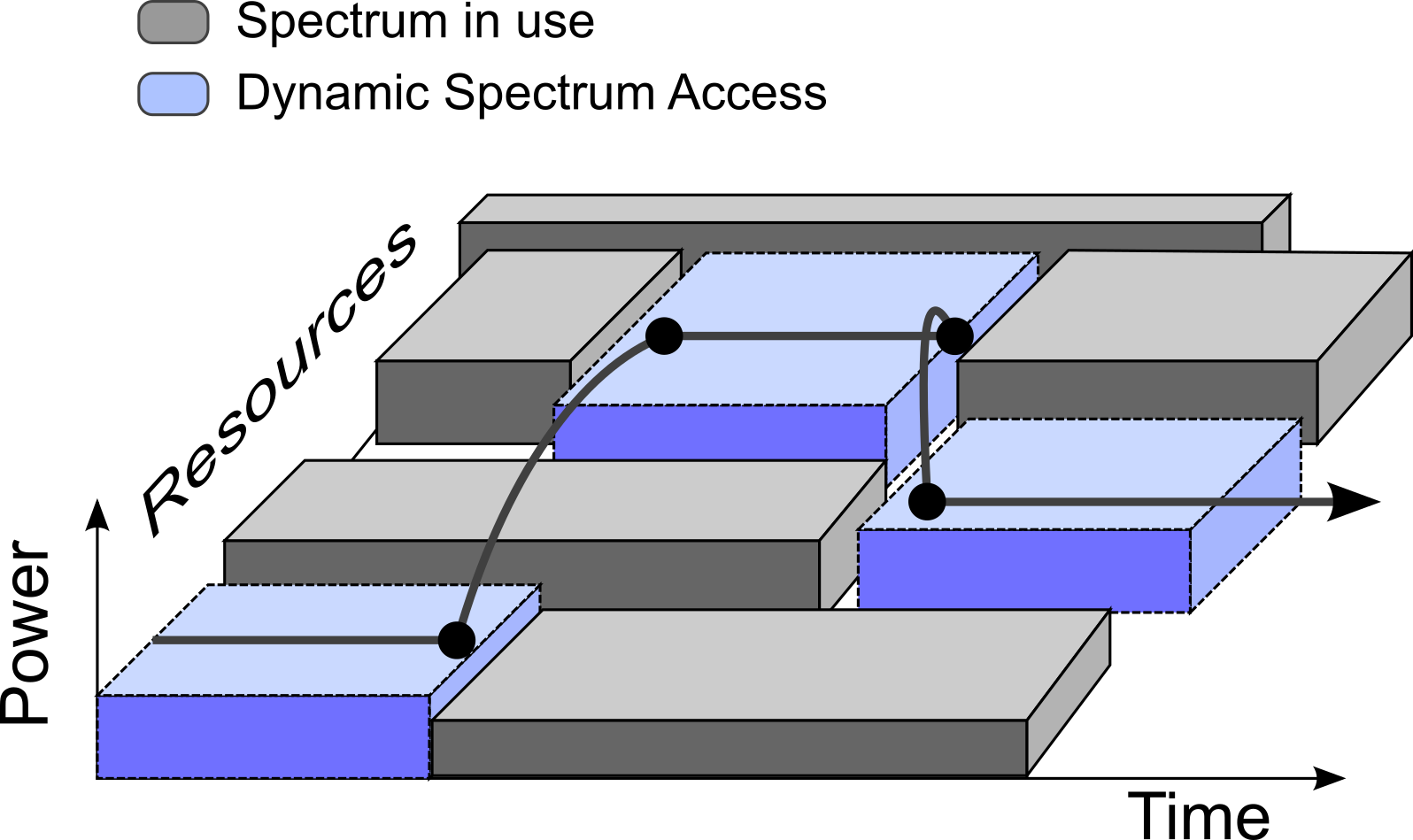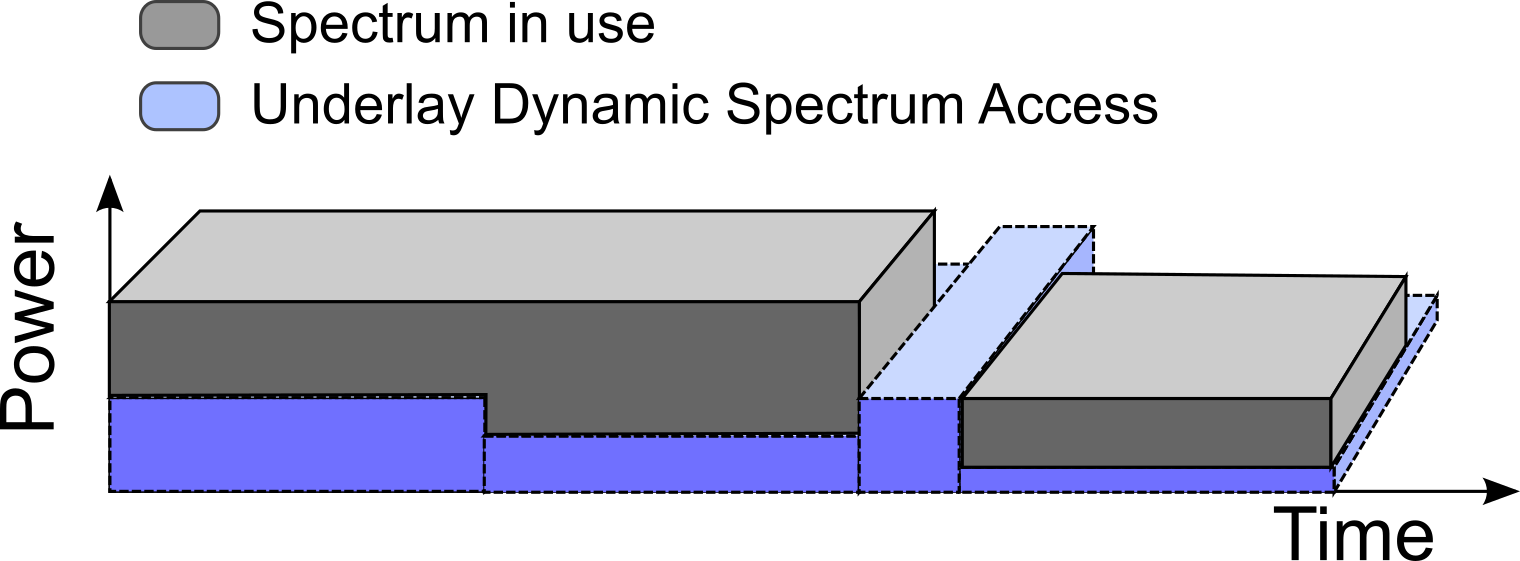Interference management in cognitive radio systems
This section is a brief introduction to my research on the topic of cognitive radio, covering mainly the content included in my doctoral dissertation [1]. This PhD Thesis contributes to the field of cognitive radio in two different ways. On the one hand, using game theoretical tools, we analyze a framework for interference management in which certain interaction is allowed between primary and secondary systems. Then, we address the problem of primary user monitoring using novel detection schemes exploiting multiple antennas, wideband processing, and available knowledge about primary transmissions.
Preliminaries
In the last years we have witnessed the apparent scarcity of spectral resources while most of the allocated spectrum is underutilized. What may look like a paradox it is only the waste of spectral resources. Most of the useful spectrum is allocated to licensed users (eg. mobile carriers, TV broacasting companies) that do not transmit at all the geographical locations all the time.
If this spectrum is opened for unlicensed use (eg. private users, short range networks, …) it is highly likely that a vast array of new services will appear. One example of this is for example the huge innovation that has occurred in WiFi and Bluetooth operating in unlicensed bands, even though these two standards share just scraps of undesirable spectrum with many other technologies.
However, before opening the licensed spectrum to new users in a Dynamic Spectrum Access (DSA) basis it is necessary to guarantee to the primary users, that own the rights over these bands, that they will not be interfered. Cognitive radios (CR), first proposed by Mitola in his landmark paper, have been chosen as an enabling platform in realizing such dynamic spectrum sharing due to their built-in cognition capabilities. A cognitive radio system is a 'smart’ network that can observe, learn from, and adjust to changing environment conditions.
A common assumption in cognitive radio systems is that the licensed users which own the spectrum rights are unaware of the presence of secondary users. Hence the burden of interference management relies mainly on the secondary system. In particular, either (i) there is a maximum interference level that the primary system is willing to tolerate, and the secondary powers/activity are to be adjusted within this constraint, hence both primary and secondary users transmit in the same band, or (ii) secondary users are allowed to opportunistically access the spectrum on the basis of no-interference to the primary (licensed) users. These two paradigms fit into what is commonly known as hierarchical-access schemes, refering to the fact that secondary users need to fulfill the constraints imposed by the primary user.

(i)

(ii)
The main contributions presented here are related to both underlay and overlay dynamic spectrum access paradigms. On the one hand, assuming that certain cochannel interference is permited at the primary network, we analyze the performance increment obtained when primary users can play an active role in the interference management procedure, i.e. primary users may interact with secondary systems. Then, assuming a non-interfering DSA network we propose and analyze novel asynchronous multiantenna and wideband detection schemes which allow the secondary network to discover and track the existing whitespaces in the monitored band.
Dynamic Spectrum Leasing
If the primary users are granted the rights to sell or trade their spectrum to third parties, they may be willing to accept interference by a secondary system for a given monetary reward. In this case, the primary users are aware of the presence of secondary systems and they can play an active role in the interference management proceduce.
In this scenario the primary users may adjust the extent to which they are willing to lease their spectrum in order to maximize their reward, for example, by broadcasting the allowed interference cap (ICAP). This paradigm will be denoted in the following Dynamic Spectrum Leasing (DSL). In [2] we study theoretically how much can be gained by allowing the primary users to dynamicaly adjust their ICAP with respect to other schemes in which the ICAP is fixed a priori by regulatory authorities. This theoretical limit can be seen as an upper bound on the attainable peformance by any practical DSL scheme.
A practical DSL scheme is proposed in [3], in which each of the secondary users acts in a selfish manner trying to maximize their own individual rate. The primary users in this network actively adapt the maximum secondary interference they are willing to tolerate, according to the expected reward, observed RF environment and their required Quality-of-Service (QoS). The performance of this DSL scheme has been analyzed in the presence of dynamic conditions (fading, number of secondary users…) in [4].
Considered altogether, this analysis shows that allowing certain interaction between the primary and secondary networks can increase the system performance and conduct to a better spectral utilization Moreover, game theory can be used to design practical DSL schemes which can deal with complex dynamic environments.
Spectrum Monitoring
On the other hand, when opportunistically accessing temporally and/or spatially unused licensed bands, as in overlay dynamic spectrum access schemes, the probability of collision with licensed (primary) users must be kept at sufficiently low levels. The nature of wireless channels makes reliable detection of primary users a challenging task: due to fading and shadowing phenomena, the received primary signal may be very weak, resulting in negative Signal-to-Noise Ratio (SNR) operation conditions. Hence, one of the key aspects to allow opportunistic access to licensed bands is the development of powerful spectrum monitoring techniques.
In the last years an important research effort has been carried out to determine the achievable detection performance, both individually by a single cognitive node or in a collaborative fashion. Three schemes are generally used for local sensing of primary channels: (i) energy detection, (ii) feature detection and (iii) matched filter detection. Energy detectors are a popular choice due to their simplicity. However they offer a poor performance and are susceptible to noise temperature uncertainty. On the other hand the more sofisticated feature and matched filter detectors are very sensitive to synchronization errors.
Hence, one may ask whether there are any primary signal features that could be exploited by a detector without requiring accurate synchronization. For example, knowledge of the spectral shape of primary transmissions is usually available to the secondary network. In our research we assume the modulation / channelization of the primary network known to the spectral monitor. We pose the problem of primary user detection from an asynchronously sampled version of the band of interest.
Under this model, which is the best detector we can design?
To answer this question we have to specify the radio front-end of the spectral monitor, since it will determine the signal available to the digital signal processing layer.

Fig. 2 shows the conceptual block diagram of the radio front-end that may be present in a cognitive node. From left to right we can see the following structural blocks:
Multiple antennas: Multiple-input multiple-output (MIMO) technologies have reached maturity and it is very likely that future Cognitive Radio networks will incorporate them. The use of multiple antennas allows to increase detection performance, attain an increased detection diversity and to fight noise uncertainty. Wideband front-end: A CR node must be able to work in different spectral bands in order to efficiently use the available whitespaces. A common wideband frontend allows the simultaneous analysis of multiple communication channels, and thus reduces the time required to detect a white space or react to the presence of a primary user. Analog to Information Converter (A2I): Wideband processing largely increases the amount of data to process by the digital processing unit. In certain cases novel techniques such as compressed sampling can be used to reduce the sampling rate below Nyquist. We denote this sampling unit as A2I to distinguish it from the classical ADC. Therefore the spectrum monitor may have to deal with a compressed sampled version of the signals acquired from multiple antennas, and possibly covering several primary channels. The proposed approach to this complex detection problem is the “divide and you shall conquer” strategy. In the following we study each of these blocks independently.
Multiantenna detection One way to enhance detection performance is to exploit the availability of multiple antennas at the secondary terminal. As in wireless communication reception, multiple antennas provide spatial diversity when the detector faces fading channels even when a rudimentary energy detector is used. The notion of detection diversity in spectral sensing can be defined similarly as in the field of communications, i.e. asymptotic slope (in log-log scale) of the probability of misdetection versus the average SNR. This analysis can be found in [5] for a energy based detector. However, other definitions of detection diversity are possible. For example, in the field of radar Daher and Adve define detection diversity as the slope (in lin-lin scale) of the probability of detection versus the average SNR around the point at which the proabability of detection is 0.5. An analisys of of this performance metric for a set of centralized and distributed detectors can be found in [6].
If additional information is available about the primary signal, it should be also exploited to improve detection performance. In several cases of interest the modulation / channelization of primary transmissions can be assumed known up to a scale factor, e.g. broadcasting networks, GSM band… This a priori knowledge is exploited in [7] to derive a family of powerful multiantenna detectors.
Another important issue in spectrum sensing is the noise level uncertainty problem. If the noise level is not perfectly known, the received signal power can be masked by the uncertainty about the noise statistics, hence an SNR wall exists below which it is not possible to detect the primary users. In order to derive detectors robust to noise uncertainty under a Gaussian model, the differences between the (spatial and/or temporal) second order statistics of the signal and noise can be exploited. To this end different models for the primary signal and noise processes can be assumed. For example, callibration errors may conduct to different noise levels across antennas. The following table summarizes the most relevant models in the field of cognitive radio. The column Ref. includes a reference to the paper in which that model was considered:
| Primary signal spatial rank | Primary signal temporal correlation | Noise process spatial structure | Ref. |
| 1 | White | Uncorrelated i.i.d. | [8]\(^*\) |
| 1 | White | Uncorrelated non-i.i.d. | [8] |
| P | White | Uncorrelated i.i.d. | [9] |
| P | White | Uncorrelated non-i.i.d. | [9] |
| 1 | Colored | Correlated | [10] |
Table 1: Multiantenna detection under unknown noise statistics. \(^*\)See references therein.
Wideband detection Intuitively, if multiple primary channels are simultaneously acquired and channelization information is available, the guard bands between adjacent channels could be used to estimate the noise power. If we pose the Generalized Likelihood Ratio Test (GLRT) under this model we observe that several of the system parameters are unkown to the spectral monitor and need to be estimated.
In [11] we study the problem of Maximum Likelihood estimation of the power spectral density of the received signal under the presented model and compare it to the performance of the Cramer-Rao lower bound. While this estimator shows a good performance, it results into a complex iterative algorithm which offers no insight into the detection problem. Therefore, we propose a simplified estimator which, in certain cases of interest, also meets the Cramer-Rao performance bound.
By applying this simplified estimate to primary user wideband detection [12], we showed that, as it could be expected, guard bands between adjacent channels are exploited to estimate the noise power and fight noise uncertainty. However, the resulting quasi GLRT detector also exploits empty and weak channels from the band of interest to increase the noise level estimation accuracy. As a result, the performance of the quasi GLRT detector will depend on the activity present on the band, offering better results in bands with low use.
Detection from compressed meassurements If only a compressed version of the received signal is available to the spectrum monitor, we have to restort into additional propoerties of the input signal to derive primary user detectors without significant performance loss. In [13] we assume sparsity in the “channel occupancy domain” to derive a joint estimator/detector that reconstructs the spectrum in the band of interest.
This fits into the more general framework of constrained estimation, where the parameter domain is restricted in a given way, in our case by its sparsity.
